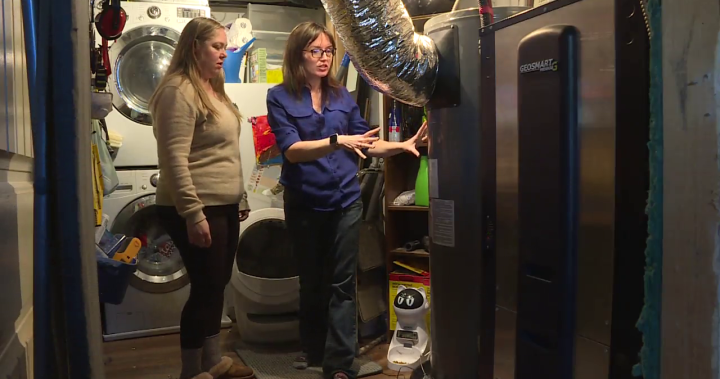A failed furnace in the middle of a cold snap set one Alberta family on the path to making their home net zero. And it could also win them a national award.
“Our furnace kicked the bucket last March in the last cold snap. And that was kind of our instigating moment,” Samantha Shannon said.
With her Airdrie, Alta., home being built in the 1980s when energy efficiency standards were much more lax, ensuring the home creates more energy than it consumes was a tall task.
Rather than just add more insulation, the Shannon family – self-described “energy efficiency enthusiasts” – took a different approach. They installed a ground source heat pump, put in a hybrid hot water tank that uses ambient home air temperature and electricity to heat the water, installed rooftop solar panels and sealed up the envelope of the home. Their detached garage got an air source heat pump because those appliances aren’t quite able to be standalone sources of heating in extreme cold temperatures.
“The biggest takeaway for us, I think, has been all the different things that you can do to your house to reduce your carbon footprint,” Kevin Shannon, Samantha’s husband, said. “When you talk about going green, the first thing that comes to people’s mind is usually putting solar panels on the top of your roof, and those are great. But there’s a lot of other things that you can do, depending on what your goals are.”
Like any home renovation, the family of five saw some disruption during the drilling of multiple 250-foot-deep holes for the heat pump or having a 19.1-kilowatt photovoltaic system installed on their roof.
“It was great to see things starting to actualize. But yes, when our front yard was dug up and we had eight-foot trenches and we had the drilling rigs, it was a little bit destructive to the house, but it was also very cool,” Kevin said. “And the kids loved that part of it, too.”
Along the way, the Shannon family applied and became contestants in the Canadian Geographic’s Live Net Zero challenge. This year’s winner gets $50,000 and each of the approved eight families got $5,000 in seed money, which the Shannons put toward sealing up their home’s air ducts and vents.
The Shannons will enter the judging phase of the contest in weeks, and the winner will be announced at the end of the month.
Get the latest National news.
Sent to your email, every day.
Samantha said she’s been interested in sustainability going back to her Grade 9 science fair while researching wind turbines.
“The idea of free and sustainable energy has always fascinated me,” she said.
Prior to working on her home, Samantha met with a number of building scientists through her work to better understand what is possible in reducing a home’s energy usage.
She said she enjoyed watching her fellow contestants for the past year, as all of the families documented their journey to net zero.
“They were all brand new to this. They’ve been able to learn so much and it’s been phenomenal,” Samantha said.
The Shannons have also been an inspiration in their community.
Samantha’s friend Kylie Franklin said in their conversations throughout the renovation process, most of the technical information went over her head. But the idea of adding the costs to their mortgage with the effect of a minor increase in monthly payments made a lot of sense to her.
“Right away in my head, it was sort of like, ‘Oh, that’s like renting a house versus owning a house.’ You’re paying yourself. You’re paying your mortgage. That money is going to come back to them in the end whether they sell or whatever,” Franklin said. “Whereas when you’re paying an electricity company, it’s just gone every single month.”
The day Atco, their natural gas utility, came to disconnect the home was another landmark day for the Shannons.
“They cut off the meter and they took it away. And it was really exciting when I got that bill and it said, ‘last bill,’” Samantha said. “No (more) admin fees, no transmission (fees).”
Samantha said things like a kitchen renovation is next on the list, a reno that will be funded by their energy savings.
She also said they’ve “future proofed” their house, by making sure it meets the upcoming 2050 building codes that will require new homes to be net zero.
“We’ve made sure that we’re securing the value of this house, because it will still be able to compete with those houses that meet the 2030 and the 2050 building codes.”
The Shannon family said regardless of the competition’s result, they are proud of the work they’ve done to get their home to a place of creating more energy than it consumes.
“We didn’t think we could get to net zero. We were just trying to get as close as we could. We hit that target, plus some,” Samantha said.
“That’s a really proud moment, whether we win or lose the Canadian Geographic challenge.”
© 2024 Global News, a division of Corus Entertainment Inc.




